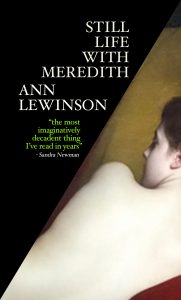What’s in Your Drawer? By Ann Lewinson
 What’s in Your Drawer?
What’s in Your Drawer?
By Ann Lewinson
You’ve probably spent at least some of the past six weeks cleaning out closets and drawers and making room in your kitchen cabinets for all those canned beans. And after throwing out some ancient William Sonoma mulling spices and washing equally ancient bandanas on hot, perhaps you came across an old manuscript, stuffed in a manila envelope, battered and nearly forgotten.
I say “nearly” because as much as you tried to forget this manuscript—it was too gnarly, you had written yourself into too many corners—you could not. It lurked in the back of your mind, nagging you to finish it. But its problems seemed insurmountable. And thus it had been put away, for a time such as this.
Still Life with Meredith was such a manuscript. I had been working on it, off and on, for several years, finally putting it aside to write a novel. It was a relief to shove it in a drawer. Its narrator was difficult to spend too much time with. The narrative went to unpleasant places.
But one day, packing for a residency in Italy, I tossed that manila envelope in my suitcase. It wasn’t until I had claimed my work space in a deconsecrated church overlooking the medieval village of Toffia, high on a limestone ridge 45 minutes east of Rome, that I opened that envelope and spread its contents on my desk.
It contained about 70 pages of manuscript, newspaper clippings about art exhibits, print-outs from websites about animal reproduction and female circumcision, spiral notebooks brimming with arcana scribbled down at the New York Public Library, and even one very early draft, which went in an entirely different direction, printed on dot-matrix paper.
It was with some trepidation that I sat down to read that manuscript. But it wasn’t long before I realized that it was something worth working on.
The manuscript was about an art handler at a contemporary museum—an “animal wrangler,” actually, since she tends to art made from and with animals, living and dead. I had been inspired by Damien Hirst’s sliced cows in New York and Annette Messager’s taxidermied sparrows in sweaters in the Pompidou. The three other residents were visual artists, and they gave me plenty of suggestions.
How about Joseph Beuys’ performance with a coyote? (They had all been influenced, in one way or another, by the German conceptualist.) That went into the book. One shared a postcard for a friend’s piece in which she lay down with pigs. That also went into the book. We visited a house renovated by a local architect, in which he had discovered, behind an old winemaking vat, a mummified cat. I took pictures. It wasn’t art, or even “art,” but it had to be in the book.
Our first weekend coincided with a three-day festival honoring Santa Maria. I’d never lived in a place in which everyone shared the same religion—and where religion was a very big deal. Under my window, the teenagers in the town band rehearsed a solemn dirge for Sunday’s procession.
A young couple dressed for clubbing lit oil lamps on paper plates leading the way to Santa Maria Nova, a 16th century Renaissance church up a winding street, at the highest point in the village. On Sunday, everyone gathered to watch the procession up the hill, rows of boys and men carrying icons through the streets.
Immersed in this monoculture, I became fascinated by it. I’m Jewish and an atheist, and to be surrounded by believers—and believers in the mysteries of Roman Catholicism at that—opened up a new line of inquiry. I had written quite a bit about female circumcision, but what about male? I soon learned that one of Jesus’s most contentious relics was—being Jewish—his foreskin. So many churches in France and Italy had claimed to have it in their possession, as recently as the 1980s! I dove down another rabbit hole. All of this went into the book.
And here’s the funny thing: this weird little manuscript that I had such a hard time finishing was the one that got published first. And it wouldn’t be what it was if I hadn’t thrown that manila envelope in my suitcase.
Now, here I am reminiscing about four weeks in the glorious Italian countryside eating figs picked from the trees, and most of us are all stuck at home until who knows when. Should be the perfect conditions to create your own little residency, right? Maybe not.
An American friend working on a novel in Berlin tells me she’s found that being quarantined in a studio apartment has not helped her writing at all; she needs the stimulation one gets from wandering, from unexpected encounters, from the sheer serendipity of urban life. I’m much the same. I can’t seem to write at the moment. But I can take inventory of all those old notebooks, consider which stories might be worth continuing.
So, as you clean out those cabinets and drawers, perhaps you’ll come across a battered manila envelope left for dead. Maybe you’ll find it in a folder on your desktop, or in an old notebook whose crushed spiral makes it hard to turn the pages. Take a moment, sit down and read that thing. You might just have something.
—
About Ann Lewinson:
Ann Lewinson is the author of Still Life with Meredith (Outpost19). Her fiction has appeared in Agni, Hayden’s Ferry Review, MoMA PS1’s Special Projects Writers’ Series and other places. A 2014 fellow at the Edward F. Albee Foundation, she is also a playwright, journalist and film critic who has reviewed movies for ARTnews, The Boston Phoenix, The Hartford Advocate and The Kansas City Star. She lives in New York. Read more at annlewinson.com.
STILL LIFE WITH MEREDITH
 Behind the glass windows of a storefront-turned-apartment, an art handler at a contemporary art museum sits among dead birds awaiting the return of her roommate, an emerging artist of growing notoriety.
Behind the glass windows of a storefront-turned-apartment, an art handler at a contemporary art museum sits among dead birds awaiting the return of her roommate, an emerging artist of growing notoriety.
While she waits, she ransacks her past while discoursing on Dutch still life painting, the mating habits of her species and others, and the extreme measures taken by the French psychoanalyst Marie Bonaparte to achieve sexual fulfillment.This audacious burning match of a novella marks the debut of a writer of uncommon insight, boundless curiosity and mordant wit, whose jaundiced eye takes on the comic excesses of contemporary art and the multifariousness of bad sex in equal measure.
Masterful in its breadth-at once funny, shocking and erudite-Still Life with Meredith contemplates the thin line that separates sanity from madness in a world that has a hard time telling the difference.
Category: On Writing























